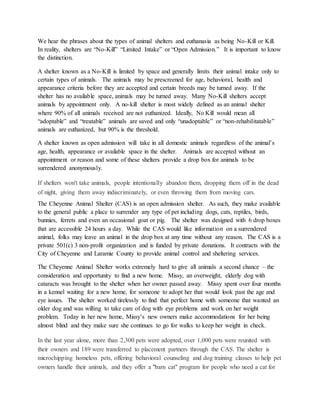
No kill
- 1. We hear the phrases about the types of animal shelters and euthanasia as being No-Kill or Kill. In reality, shelters are “No-Kill” “Limited Intake” or “Open Admission.” It is important to know the distinction. A shelter known as a No-Kill is limited by space and generally limits their animal intake only to certain types of animals. The animals may be prescreened for age, behavioral, health and appearance criteria before they are accepted and certain breeds may be turned away. If the shelter has no available space, animals may be turned away. Many No-Kill shelters accept animals by appointment only. A no-kill shelter is most widely defined as an animal shelter where 90% of all animals received are not euthanized. Ideally, No Kill would mean all “adoptable” and “treatable” animals are saved and only “unadoptable” or “non-rehabilitatable” animals are euthanized, but 90% is the threshold. A shelter known as open admission will take in all domestic animals regardless of the animal’s age, health, appearance or available space in the shelter. Animals are accepted without an appointment or reason and some of these shelters provide a drop box for animals to be surrendered anonymously. If shelters won't take animals, people intentionally abandon them, dropping them off in the dead of night, giving them away indiscriminately, or even throwing them from moving cars. The Cheyenne Animal Shelter (CAS) is an open admission shelter. As such, they make available to the general public a place to surrender any type of pet including dogs, cats, reptiles, birds, bunnies, ferrets and even an occasional goat or pig. The shelter was designed with 6 drop boxes that are accessible 24 hours a day. While the CAS would like information on a surrendered animal, folks may leave an animal in the drop box at any time without any reason. The CAS is a private 501(c) 3 non-profit organization and is funded by private donations. It contracts with the City of Cheyenne and Laramie County to provide animal control and sheltering services. The Cheyenne Animal Shelter works extremely hard to give all animals a second chance – the consideration and opportunity to find a new home. Missy, an overweight, elderly dog with cataracts was brought to the shelter when her owner passed away. Missy spent over four months in a kennel waiting for a new home, for someone to adopt her that would look past the age and eye issues. The shelter worked tirelessly to find that perfect home with someone that wanted an older dog and was willing to take care of dog with eye problems and work on her weight problem. Today in her new home, Missy’s new owners make accommodations for her being almost blind and they make sure she continues to go for walks to keep her weight in check. In the last year alone, more than 2,300 pets were adopted, over 1,000 pets were reunited with their owners and 189 were transferred to placement partners through the CAS. The shelter is microchipping homeless pets, offering behavioral counseling and dog training classes to help pet owners handle their animals, and they offer a "barn cat" program for people who need a cat for
- 2. the farm. A huge help to the community is the “Big Fix” program, a low cost spay neuter and income based program for pet owners that qualify. The animal shelter does not take the decision to euthanize lightly and it makes every effort to avoid euthanizing any animal in its care. The CAS is spending more on veterinary care than ever to save lives and spay and neuter animals. The problem is simply that we do not have enough homes for the number of animals that need one. We need to cut off the source for homeless animals by investing in low-cost spay neuter programs, support trap and release programs for feral cats, expand education regarding the benefits of spay and neuter and finally, encourage people to adopt animals from shelters and rescue groups. Current statistics show that as a country we euthanize over 4 million animals in shelters annually. One female cat and her offspring can theoretically produce 420,000 cats in a lifetime and one female dog, 67,000 dogs in 6 years. CAS works with a number of rescue groups to rehome adoptable animals; animals that may have been in the shelter for too long, sometimes purebreds or difficult to place breeds. They work with other shelters in the surrounding area to accept more animals if they have the room. The shelter has an extensive foster program, working with individuals to care for newborn kittens and puppies and sometimes entire litters. Both types of shelters and rescue groups are working toward a common goal – to rehome as many animals as possible. The employees, boards and volunteers of either type of shelter share the same compassion and care for animals.